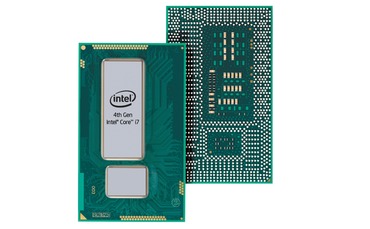
Intel has released details about its forthcoming i-series microprocessors, dubbed "Haswell", which it claims will feature radically reduced power consumption.
The details cover the high-end quad-core Core i7 and Core i5 microprocessor families - 12 intended for desktop PCs and 10 for laptops and ultrabooks.
Haswell features a new architecture that will supersede the current Ivy Bridge/Sandy Bridge range. It will be built on Intel's 22 nanometre 3D tri-gate manufacturing process, while next year's update to Haswell, code-named Broadwell, will be built on the 14 nanometre process that Intel is currently working on.
In particular, the Haswell architecture is designed to make the most of the move to FinFET transistors in the 22 nanometre process, while providing system builders with a more modular architecture to put together different devices, from servers and high-end tablet computers to cheap desktops.
The main claims that Intel is making of Haswell, though, are not in terms of improved performance, which will be only marginally improved, but in much-reduced power consumption.
One of the key features of Haswell is the integrated graphics processing unit (GPU), which Intel claims will offer between two and three times the performance of existing Ivy Bridge parts. That means that it will not just be able to play some of the latest games (passably), but also handle video encoding and decoding.
Different specialist semiconductor and technology web sites have their own analysis of the specifications:
"The K-Series parts are utterly crippled. Yes Intel gifted us with unlocked parts for about 10 per cent more, or should we say that they didn't remove the overclocking features for a steep price? Unfortunately what they removed is much more than 'clock locks' and definitely more useful to the buyer. If you read the chart, vPro, TXT, VTd, and SIPP are removed, as is transactional memory, but they don't tell you that. If you get a K-Series device you can't use virtualisation, none of the management features are there, and neither is the hardware security that they said you absolutely needed last generation."
Semiaccurate
"It's fair to say that Haswell doesn't do much for desktop enthusiasts -- a few percentage points of compute performance perhaps, but nothing like the major improvements for mobile SKUs and integrated graphics."
Engadget
"Some of these power savings come because Haswell is the first architecture tailored specifically for the 22nm process rather than being designed for a larger process and then shrunk down, as Ivy Bridge was. Others come from improvements that Intel has made it to idle power usage and the amount of power used when switching between those active and idle states. A new "active idle" power state, also dubbed S0ix, allows the system to continue sending and receiving data without powering the CPU and GPU all the way up. This increases the amount the system can do without being "active" and reduces the amount of power needed to switch to a fully active state."
Arstechnica
"Intel engineers explained that they fully integrated the power management system this time around, integrating a whole host of voltage regulators into a single controller. That controller can dynamically ramp the voltage much quicker, allowing the chip to work harder when you need it to, and cool down when you don't. (It also should allow these laptops to wake up faster from sleep mode.)"
The Verge
"As it stands, there aren't a great number of reasons for desktop users with Sandy Bridge or Ivy Bridge platforms to rush out and upgrade - indeed, if you're a gamer with a discrete card, you're unlikely to see a major frame-rate differential between any of the three generations, and you may find less over-clocking headroom."
Hexus
"Frankly speaking, this product is not that impressive at all... Core i7-4770K is just a little bit faster than the flagship Ivy Bridge processor. Microarchitectural improvements only provide a 5-15 per cent performance boost... Second, [the] Core i7-4770K processor turned out a significantly hotter processor than the CPUs based on previous microarchitecture. Even though Haswell allows engineering energy-efficient processors with impressively low heat dissipation, its performance-per-watt has worsened a lot when they adjusted its characteristics to meet the desktop requirements..."
Xbit Labs
"Haswell is 6-10% faster than Ivy Bridge, almost without exception... This design has legs for the long haul, and there are going to be people in certain fields who are downright excited to see it ship. The new core, with its integrated VRM and lower-power targets in mobile, was unlike anything Intel has built before, and the company managed to increase execution efficiency while keeping power consumption steady on the desktop."





